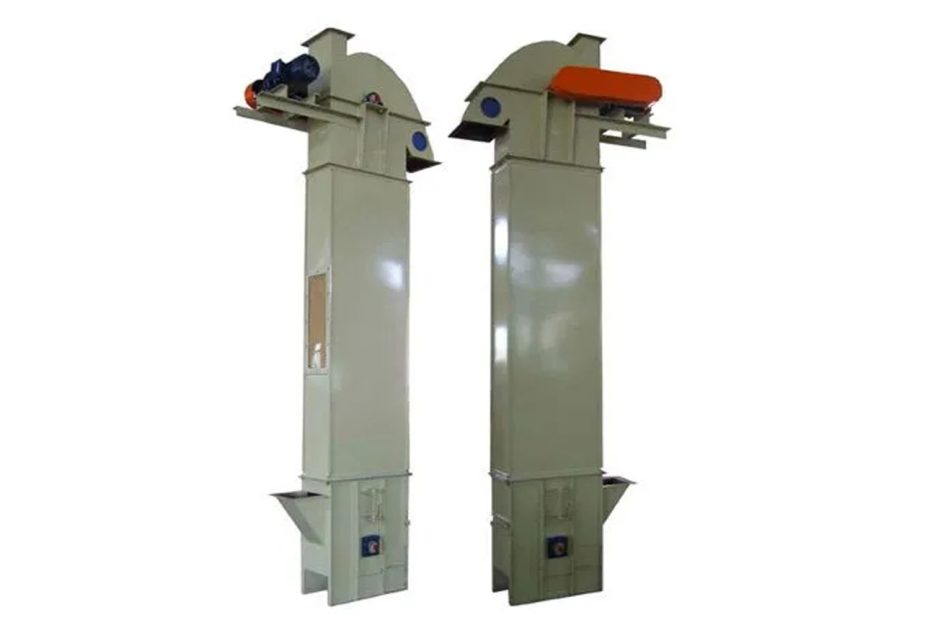Bucket elevator is a common material vertical conveying equipment, which is mainly used to convey materials from low to high or from above to below, and is widely used in building materials, chemical industry, grain, mining and other industries.
The working process of the bucket elevator can be divided into three steps: loading, lifting and unloading. Among them, unloading is a step in the work of the bucket elevator.
When the hopper reaches the head of the bucket elevator, it starts to move in a uniform circular motion along the head wheel. With the turning of the hopper, the material in the hopper leaves the hopper and is guided to the discharge port under the action of gravity and centrifugal inertial force. This process is called discharge.
Uniform circular motion refers to the uniform circular motion of the hopper along the head wheel on the machine head. This form of movement can ensure the uniform distribution and stability of the material in the hopper, thereby promoting the efficiency and accuracy of unloading.
Three ways in the bucket elevator unloading process
In the unloading process of the bucket elevator, the unloading forms mainly include three types: centrifugal, gravity and mixed.
Centrifugal unloading
Centrifugal unloading refers to the unloading method in which the material is driven by the driving mechanism of the bucket elevator, and after the material is lifted to a certain height through the upper hopper, it is thrown out of the hopper by centrifugal force. This discharge method is suitable for materials with small particle size, light specific gravity, large bulk and poor fluidity, and the hopper rotates at a high speed. For example: cement, flour, stone powder, etc.
In centrifugal unloading, the high-speed rotation of the lifting bucket can generate centrifugal force to throw the material outward. During the throwing process, the material has a higher speed and a smaller drop, so the material is discharged faster and more efficient. higher.
However, when performing centrifugal unloading, it is necessary to combine the speed of the machine and the properties of the material to control the speed and rotation speed of the bucket to prevent the material from being thrown away while generating too much dust, which will affect the operating environment and unloading effect.
Gravity unloading
Gravity unloading refers to the way that the material falls naturally through the action of gravity under the action of the bucket elevator, and is placed on the receiving equipment for unloading. This unloading method is suitable for materials with large particle size and high specific gravity. During the transportation process, due to the large self-weight of the material and the large gravity effect, the material can slide down naturally along the pipeline of the bucket, and the unloading operation is relatively simple. , not easily affected by external factors.
However, gravity unloading needs to control the speed and height of the bucket and the uniformity of the material to ensure that the drop of the material is not too large to avoid damage to the material and the operation stability of the machine. At the same time, for materials with strong adhesion or poor fluidity, gravity unloading may cause blockage and leakage, so special design and treatment are required.

Mixed unloading
The hybrid unloading combines the advantages of gravity unloading and centrifugal unloading. It adopts the effect of the gravity of the material itself, supplemented by the acceleration of the centrifugal force, so that the speed of the material is uniform during the unloading process, and the unloading is more stable. This method It is suitable for materials with high viscosity and certain self-weight, and there is certain centrifugal force in the hopper.
The mixed discharge can not only reduce the material drop, but also promote the movement and discharge of the material. During the unloading process, the material is first lifted to a certain height through the upper hopper, then accelerated in the material hopper, enters the output pipeline, and completes the unloading process of the material during the free fall process.
It should be noted that the mixed unloading needs to control the speed and acceleration, and it needs to be reasonably adjusted according to the nature of the material and the conveying height to ensure that the material does not have an excessive drop or blockage during the operation. .
In conclusion
The discharge method during the hopper discharge process depends on the nature of the material and the movement state of the hopper. Different unloading methods have different advantages and disadvantages, and are applicable to different types of materials. Reasonable selection and control should be carried out according to the characteristics of the materials and the requirements of the conveying process.
When the bucket elevator is running, the appropriate unloading method should be selected according to the actual production needs to ensure the efficiency and quality of unloading.
